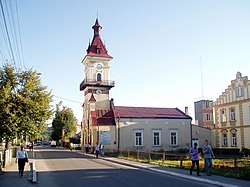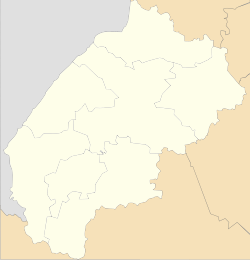Rava-Ruska
Rava-Ruska
Рава-Руська Rawa Ruska | |
|---|---|
 City hall | |
| Coordinates: 50°13′30″N 23°37′27″E / 50.22500°N 23.62417°E | |
| Country | |
| Oblast | |
| Raion | |
| Hromada | Rava-Ruska urban |
| Founded | 1455 |
| Named after | Rawa Mazowiecka |
| Area | |
• Total | 8.5 km2 (3.3 sq mi) |
| Elevation | 349 m (1,145 ft) |
| Population (2022) | |
• Total | 8,494 |
| • Density | 1,000/km2 (2,600/sq mi) |
 | |
Rava-Ruska (
History
| Year | Pop. | ±% |
|---|---|---|
| 1921 | 8,970 | — |
| 1931 | 11,146 | +24.3% |
| 2022 | 8,494 | −23.8% |
| Source: [3] | ||
Rawa-Ruska was founded in 1455 by the Polish prince
From the First Partition of Poland in 1772 until the end of World War I in 1918, the town was part of the Austrian Partition ruled first by the Austrian Empire and then by Austria-Hungary after the compromise of 1867. It was a seat of the Rawa Ruska district, one of the 78 Bezirkshauptmannschaften in Austrian Galicia province (Crown land) in 1900.[4] In 1880, its population was 10,500, with 37% Jews, 35% Poles, 20% Germans and 7% Ukrainians. In 1857, Rawa received a rail connection with Jarosław, and next year, the railroad reached Sokal.
20th century

In the early 20th century, Rava-Ruska developed into a rail junction, with a connection to Lviv and Rejowiec, built in 1915. After the rebirth of Poland Rawa-Ruska became part of the Lwów Voivodeship, and the seat of the Powiat Rawski county (area 1,401 km2 (541 sq mi)). The line from to Rejowiec was of leading importance, as it connected the two main cities of Poland, Warsaw, and Lviv. Due to the rail lines, Rawa prospered, and several businesses operated in the town. In 1924, a Belgian company opened here a factory of railroad ties. Furthermore, in the interbellum period Rawa Ruska was home to Main School of the Border Guard, which was moved there in 1928 from Góra Kalwaria. The school had a department of training of guard dogs, also located in Rawa-Ruska.
According to
World War II and the Holocaust

On 14 September 1939, during the
The
The Germans also operated the Stalag 325
After World War II
After World War II, the Polish community of Rava-Ruska was forced to abandon the town and move to the Recovered Territories. Nevertheless, Rava-Ruska remains one of the key centres of the Polish minority in Ukraine, with the local office of the Association of Polish Culture of the Lviv Land operating here.
Until 18 July 2020, Rava-Ruska belonged to Zhovkva Raion. The raion was abolished in July 2020 as part of the administrative reform of Ukraine, which reduced the number of raions of Lviv Oblast to seven. The area of Zhovkva Raion was merged into Lviv Raion.[10][11]
Geography
Climate
| Climate data for Rava-Ruska (1981–2010) | |||||||||||||
|---|---|---|---|---|---|---|---|---|---|---|---|---|---|
| Month | Jan | Feb | Mar | Apr | May | Jun | Jul | Aug | Sep | Oct | Nov | Dec | Year |
| Mean daily maximum °C (°F) | 0.2 (32.4) |
1.6 (34.9) |
6.6 (43.9) |
14.0 (57.2) |
19.8 (67.6) |
22.3 (72.1) |
24.3 (75.7) |
23.9 (75.0) |
18.6 (65.5) |
13.2 (55.8) |
6.4 (43.5) |
1.3 (34.3) |
12.7 (54.9) |
| Daily mean °C (°F) | −2.7 (27.1) |
−1.8 (28.8) |
2.2 (36.0) |
8.3 (46.9) |
13.8 (56.8) |
16.6 (61.9) |
18.5 (65.3) |
17.8 (64.0) |
13.1 (55.6) |
8.3 (46.9) |
2.9 (37.2) |
−1.4 (29.5) |
8.0 (46.4) |
| Mean daily minimum °C (°F) | −5.6 (21.9) |
−5.0 (23.0) |
−1.5 (29.3) |
3.1 (37.6) |
8.2 (46.8) |
11.4 (52.5) |
13.3 (55.9) |
12.5 (54.5) |
8.6 (47.5) |
4.4 (39.9) |
-0.0 (32.0) |
−4.0 (24.8) |
3.8 (38.8) |
| Average precipitation mm (inches) | 35.5 (1.40) |
35.5 (1.40) |
41.7 (1.64) |
44.1 (1.74) |
77.9 (3.07) |
76.3 (3.00) |
90.1 (3.55) |
77.5 (3.05) |
70.3 (2.77) |
44.0 (1.73) |
43.6 (1.72) |
40.0 (1.57) |
676.5 (26.63) |
| Average precipitation days (≥ 1.0 mm) | 8.7 | 9.1 | 8.7 | 8.5 | 10.9 | 10.5 | 10.4 | 8.5 | 9.0 | 7.5 | 9.5 | 9.8 | 111.1 |
| Average relative humidity (%)
|
84.1 | 82.0 | 77.7 | 70.6 | 71.4 | 74.4 | 75.3 | 75.8 | 80.0 | 81.3 | 84.9 | 86.0 | 78.6 |
| Source: NOAA[12]
| |||||||||||||
Transportation
It is located near the border with Poland, opposite the town of Hrebenne. Through the city passes the European route ![]() E372. At the border there is a "checkpoint Rava-Ruska".
E372. At the border there is a "checkpoint Rava-Ruska".
Rail station
The city has a railroad station which also has a border and customs checkpoint. Since 2005 it has been used exclusively for freight transportation only and has two directions, one towards Hrebenne, another towards Werchrata.



Points of interest
- Parish church of St. Joseph, built in 1700 - 1776 upon the initiative of Castellan of Belz Andrzej Rzeczycki. During the Soviet era the church served as a warehouse.
- Franciscan Abbey of Archangel Michael, founded in 1725 by Starosta of Belz Grzegorz Rzeczycki and Jozef Glogowski. The complex of the abbey and the church was completed in 1737 by architect Pawel Fontana, and was one of the most interesting sights of the town. In the Soviet Union, the complex was turned into a warehouse serving the local collective farm.
Notable people
- Walter V. Bozyk, conductor, bandurist
- Maurice Abraham Cohen (1851–1923), Australian educator and linguist
- Edward Olearczyk (1915-1994), Polish composer
- Iryna Vereshchuk, deputy prime minister of Ukraine
- Minister of Religious Affairs
See also
References
- ^ "Рава-Руська міська громада" (in Ukrainian). Портал об'єднаних громад України.
- ^ Чисельність наявного населення України на 1 січня 2022 [Number of Present Population of Ukraine, as of January 1, 2022] (PDF) (in Ukrainian and English). Kyiv: State Statistics Service of Ukraine. Archived (PDF) from the original on 4 July 2022.
- ^ Wiadomości Statystyczne Głównego Urzędu Statystycznego (in Polish). Vol. X. Warszawa: Główny Urząd Statystyczny. 1932. p. 140.
- ^ Wilhelm Klein (1967), Die postalischen Abstempelungen auf den österreichischen Postwertzeichen-Ausgaben 1867, 1883 und 1890. [clarification needed]
- ^ a b c Chris Webb; Chip Sother (2011). "Rawa Ruska". H.E.A.R.T. HolocaustResearchProject.org. Retrieved 21 October 2015.
- ISBN 978-0-253-35599-7.
- ^ "Holocaust by Bullets". Yahad-in Unum. Retrieved 19 June 2020.
- ^ Yahad-In Unum. "Execution Sites of Jewish Victims Investigated". Yahad Map.org. Retrieved 18 December 2014.
- ^ ISBN 978-0-253-06089-1.
- ^ "Про утворення та ліквідацію районів. Постанова Верховної Ради України № 807-ІХ". Голос України (in Ukrainian). 2020-07-18. Retrieved 2020-10-03.
- ^ "Нові райони: карти + склад" (in Ukrainian). Міністерство розвитку громад та територій України.
- National Centers for Environmental Information. Archived from the original(XLS) on 17 July 2021. Retrieved 17 July 2021.
External links
- Rava-Ruska City Council Archived 2014-04-29 at the Wayback Machine
- Ukrainians visit Nazi atrocity sites as taboo ends, BBC News (19 July 2015)
- The Jewish Community of Rava-Russkaya, The Museum of the Jewish People at Beit Hatfutsot




